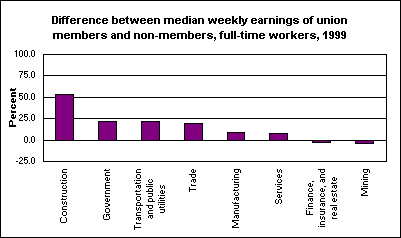An official website of the United States government
 United States Department of Labor
United States Department of Labor
Median weekly earnings for union members who worked full time in 1999 were about 30 percent higher than the median for nonunion workers. Union members had median usual weekly earnings of $672, compared with a median of $516 for wage and salary employees who were not represented by a union.

[Chart data—TXT]
Earnings differences varied widely among broad industry groups. The largest difference was found among workers in the construction industry. Union members there earned $778 a week, more than half again the earnings of nonunion workers in the industry.
Earnings for union members were about one-fifth higher than those for non-members in government, transportation and public utilities, and trade. Smaller differences prevailed in manufacturing and services, while nonunion workers actually earned slightly more than union members in mining and finance, insurance, and real estate.
These 1999 data on union membership are from the Current Population Survey. Earnings data in this article are for full-time wage and salary workers. Earnings differences reflect a variety of influences in addition to coverage by a collective bargaining agreement, including variations in the distribution of union members and nonunion employees by occupation, industry, firm size, or geographic region. Find out more in "Union Members in 1999," news release USDL 00-16.
Bureau of Labor Statistics, U.S. Department of Labor, The Economics Daily, Union members earn more in most industries at https://www.bls.gov/opub/ted/2000/feb/wk1/art03.htm (visited January 09, 2026).

